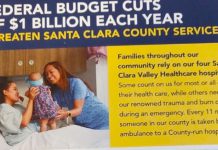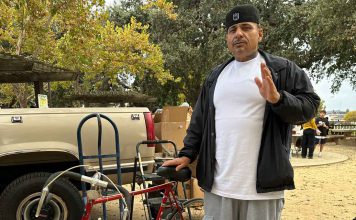Perry Woodward is more than the mayor of Gilroy. He’s been on the Valley Transportation Authority for seven years and was its chair last year. He now chairs the Caltrain board. These are two of the most important groups overseeing area transit.
Over the years South Valley residents say they have gotten short shrift in countywide transportation measures, but Woodward has been working to change that. Gilroy stands to benefit big in rail and roads in a new half-cent sales tax proposal being discussed by the VTA.
Dispatch: What do you see in Gilroy’s transportation future? How will we get around in five, 10 and 20 years?
Woodward: First, let me say that mobility and connectivity to Silicon Valley are key to Gilroy’s economic vitality. With that in mind, I have represented Morgan Hill and Gilroy on the VTA Board for the last seven years. Last year, I completed a term as the VTA board chair. I am also the current chair of the Caltrain board, where I am in my fourth year. These out-of-town commitments are time-consuming, but one of my most important roles as mayor is providing strong, effective advocacy for Gilroy on a regional basis, especially when it comes to highway construction and our future mass transit potential.
People commuting by rail will be our biggest change in the coming decades. Taking the long view, the current plan has California High Speed Rail operating from San Francisco to San Jose to the Central Valley by 2025. Of course, it could take longer than anticipated before that actually happens, given the many challenges that high speed rail faces. When it finally occurs though, there will be two stations in Santa Clara County: Gilroy and San Jose.
The increase in jobs, development, access and opportunity that will be created by this unprecedented transportation investment will change Gilroy forever. This investment goes hand-in-hand with Caltrain electrification. Electrification will increase the capacity of the current system to help manage the influx of ridership Caltrain has seen over the past few years. This will help reduce vehicle miles traveled and greenhouse gas emissions, while also increasing jobs both during and after construction.
In the shorter run, say five years, more and more people will turn to ridesharing/carpooling because of the expansion of express lanes throughout the Bay Area. The plan is to implement two lanes in each direction on U.S. 101 (funding is pending) and although this system allows solo drivers to pay a fee to use the carpool lane, these systems effectively promote finding someone to share a ride with to continue to use the lane for free. My hope is that the increased lanes on U.S. 101 will mean that the carpool lanes will actually work as intended and not grind to a halt along with the others. The first roadway like this in our county has been operating at the I-880/237 interchange in Milpitas and it has reduced travel times in the northern gateway to Silicon Valley.
Ride hailing services like Uber and Lyft are making a much bigger impact on connecting people to transit. The Metropolitan Transportation Commission and Caltrain, for example, are partnering with these companies to make that connection even stronger.
We will see more on-demand services in place, like VTA’s Flex service which is being piloted in North San Jose, to help with the first and last mile connections to transit. We hope to expand this service in other areas where people need one less barrier to riding VTA bus and light rail service.
We should see more people on bikes thanks to the expansion of bike sharing programs and increased capacity for bikes on transit vehicles. This helps accommodate those who don’t want to drive their car every day to work, but still have a need to run midday errands or need to make that longer last mile connection that can’t easily be accommodated by foot.
Dispatch: What’s been the biggest achievement in transit over the past decade? Are we where we should be?
Woodward: Countywide, getting the funding needed to bring the first 10 miles of BART to San Jose has been the biggest milestone we have achieved. In less than two years (fall 2017 opening date), a convenient BART trip will replace commuters on overly congested highway corridors I-880 and I-680. The momentum to continue BART to downtown San Jose and Santa Clara is strong and will ultimately close the commuter rail loop in the Bay Area. The plan is to have that completed by 2025. In Gilroy, we have not seen many achievements in mass transit in the last decade but we have instead been busy laying the foundation for many improvements in the years ahead.
Dispatch: Traffic keeps getting worse. Do you think it can ever improve?
Woodward: Traffic will only become better managed if more and more people exchange car trips for bus, train and bike trips. Our saving grace may be our upcoming millennial generation—our young people don’t have an interest in or are less inclined to own and maintain a car. We need to be sure that we have an efficient and viable transit solution for them before they have to turn to driving to get where they need to go. We also need to work hard to increase the jobs-to-housing ratio in Gilroy. Far too large a percentage of our population has no choice but to make the difficult commute to Silicon Valley each day in order to earn a living. A vibrant local economy with good paying jobs would help improve traffic where it is worst for Gilroyans; namely, on U.S. 101 at commute times.
Dispatch: Do you believe in high speed rail here? Do you think it can ever really happen?
Woodward: I believe it is likely to be built and operational through Gilroy in the next 20 years, if that is the question. At the governor’s insistence, there are many smart people working on making high speed rail a reality. As a Californian, I myself would be inclined to wait to build it and instead place the focus on our deteriorating infrastructure (for example, the $59 billion in unfunded road repairs that exist statewide). However, as the mayor of Gilroy, I think that the sooner it can be up and running the better it will be for our city. The Gilroy HSR station will serve the entire central coast from Capitola to San Luis Obispo. This is going to be a much-needed boost to our local economy, especially our downtown. There is also a good chance that we will benefit from the construction of a maintenance facility nearby and that means good paying jobs as well. There will be winners and losers with the construction of high speed rail, but Gilroy is poised to benefit more than virtually all other cities. Also, I am curious to see what the availability of a 30-minute train ride to downtown San Francisco will mean for Gilroy’s property values.
Dispatch: What are your thoughts on bicycle transit? Is it a necessity or just an option for very few people?
Woodward: I do believe if we make riding a bike safer and more accessible for people, more and more people will ride. You may have noticed that when re-paving certain streets in Gilroy we have started to improve the bike lanes. The funding for this is coming largely from VTA and these corridors are intended to make it easier for bike riders to get around town, especially to the train station. Also, VTA is currently updating its Bicycle Expenditure Plan and it has received great interest from the bike riding community. There is a lot of support from those who want to see trails, bike lanes and pathways expanded and improved. Caltrain is also working on improving onboard bike capacity, as well as looking at providing better options for those who want to leave their bikes at the station during the day.
Dispatch: What are your thoughts on the Silicon Valley Leadership Group’s proposal for a half-cent tax to pay for roads, trains and sidewalks?
Woodward: This is actually a joint effort between VTA and the Silicon Valley Leadership Group. I am strongly in favor of it. In fact, last year I served as the chair of the VTA committee charged with looking at whether to go forward with such a ballot measure and, if so, which highway, roadway and transit projects should be included within it. We know that people have reached a critical point of frustration when it comes to traffic congestion. We have learned that the polling they have done for this proposed half-cent tax is strong and that people are willing to invest in transit and improved roadways.
Much credit for what has been achieved so far really goes to the progressive electorate, both in Gilroy and countywide, who has had the foresight to support much-needed transportation improvements that have delivered billion of dollars worth of highway, bike and pedestrian projects over the last 40 years. As this newspaper’s editorial a couple weeks ago correctly observed, the November 2016 ballot measure contains a lot of good projects for Gilroy and would also give the city an extra $1 million each year for street maintenance.
Dispatch: How would more transit options benefit Gilroyans? Do you think commuters can be convinced to get out of their cars for mass transit?
Woodward: For transit to be attractive, it has to go where people want it to go and it has to be frequent. Honestly, there is a lot more work to be done before Gilroy will have what I see as meaningful transit service. I am grateful to those who choose to use it today, despite its limited service and other challenges. Moving forward, we need to focus on transit-oriented development as a city. And we need to stay highly engaged at the regional level with VTA and Caltrain to take advantage of any opportunities that arise for expanded service.













